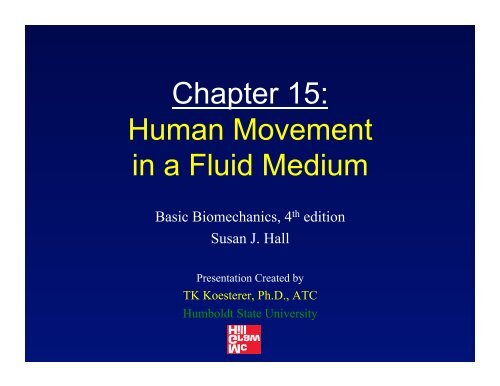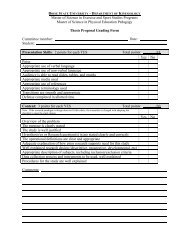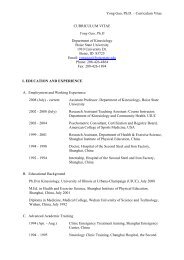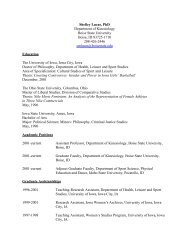Chapter 15: Human Movement in a Fluid Medium
Chapter 15: Human Movement in a Fluid Medium
Chapter 15: Human Movement in a Fluid Medium
- No tags were found...
Create successful ePaper yourself
Turn your PDF publications into a flip-book with our unique Google optimized e-Paper software.
<strong>Chapter</strong> <strong>15</strong>:<strong>Human</strong> <strong>Movement</strong><strong>in</strong> a <strong>Fluid</strong> <strong>Medium</strong>Basic Biomechanics, 4 th editionSusan J. HallPresentation Created byTK Koesterer, Ph.D., ATCHumboldt State University
Objectives• Expla<strong>in</strong> the ways <strong>in</strong> which the composition and flowcharacteristics of a fluid affect fluid forces• Def<strong>in</strong>e buoyancy and expla<strong>in</strong> the variables thatdeterm<strong>in</strong>e whether a human body will float• Def<strong>in</strong>e drag, identify the components of drag, andidentify the factors that affect the magnitude of eachcomponent• Def<strong>in</strong>e lift and expla<strong>in</strong> the ways <strong>in</strong> which it can begenerated• Discuss the theories regard<strong>in</strong>g propulsion of thehuman body <strong>in</strong> swimm<strong>in</strong>g
The Nature of <strong>Fluid</strong>s<strong>Fluid</strong>:• Air and water are fluids that exertforces on the human body.
Relative MotionRelative velocity:• Of a body with respect to a fluid is thevector subtraction of the velocity of thefluid from the velocity of the body.
Lam<strong>in</strong>ar versus Turbulent FlowLam<strong>in</strong>ar flow:– Low velocity relative to fluid mediumTurbulent flow:– High velocity relative to fluid medium
<strong>Fluid</strong> Properties• Density (ρ) = mass / volume• Specific weight (γ) = ratio of weight tovolume• Viscosity = <strong>in</strong>ternal resistance to flowAtmospheric pressure and temperature<strong>in</strong>fluence a fluid’s density, specificweight, and viscosity
BuoyancyArchimedes’ pr<strong>in</strong>ciple: the magnitude of thebuoyant force act<strong>in</strong>g on a given body is equalto the weight of the fluid displaced by thebody.• F b = V d γCenter of Volume: po<strong>in</strong>t around which a body’svolume is equally distributed and at which thebuoyant force acts.
Flotation• Depends on body’s buoyancy and itsweight• Weight = buoyant; body floats• Weight > buoyant; body s<strong>in</strong>ks
Flotation of the <strong>Human</strong> Body• Floatability is a function of body density• For flotation, buoyant force must greater thanor equal to body weight• Orientation of the human body• Torque on the float<strong>in</strong>g human body
<strong>15</strong>-3
Drag• F D = ½C D ρA p v 2Coefficient of drag:• Depends on shape & orientation of a bodyComponents of total drag force:• Sk<strong>in</strong> friction• Form drag• Wave drag
<strong>15</strong>-4
Sk<strong>in</strong> FrictionSk<strong>in</strong> friction, surface drag, or viscous drag:• <strong>Fluid</strong> particles slowed due to shear stressBoundary layer: layer of fluid immediatelyadjacent to the bodyFactors that affect sk<strong>in</strong> friction drag• Velocity of fluid flow, surface area,roughness, and viscosity
Wave DragWave drag:• Major effect on human swimmers• Factors that affect wave drag– Greater up-and-down motion– Increased swimm<strong>in</strong>g speed
Bernoulli’s pr<strong>in</strong>ciple• Pressure <strong>in</strong> a fluid varies <strong>in</strong>verselywith the velocity
<strong>15</strong>-6
<strong>15</strong>-8
Lift Force• Lift: force act<strong>in</strong>g on a body <strong>in</strong> a fluid <strong>in</strong> adirection perpendicular to the fluid flow• F L = ½C L ρA p v 2
Foil ShapeFoil: shape capable of generat<strong>in</strong>g lift <strong>in</strong> the presence ofa fluid flowBernoulli pr<strong>in</strong>ciple: <strong>in</strong>verse relationship betweenrelative velocity and relative pressure <strong>in</strong> a fluid flowFactors that Affect:– Velocity, pressure, and lift forceCoefficient of lift: unitless number that is an <strong>in</strong>dex ofa body’s ability to generate lift
<strong>15</strong>-7
Foil Shape• Semi-foil shape of projectiles such as the discusand javel<strong>in</strong> generate some lift force when oriented atappropriate angles with respect to the direction of thefluid flow.• Angle of Attack: angle between thelongitud<strong>in</strong>al axis of a body and the direction ofthe fluid flow• Lift/drag ratio: the magnitude of the lift forcedivided by the magnitude of the total dragforce act<strong>in</strong>g on a body at a given time
Magnus EffectMagnus force: lift force created by sp<strong>in</strong>Magnus effect: deviation <strong>in</strong> the trajectory of asp<strong>in</strong>n<strong>in</strong>g object toward the direction of sp<strong>in</strong>,result<strong>in</strong>g form the magnus force
Propulsion <strong>in</strong> a <strong>Fluid</strong> <strong>Medium</strong>• Resistive drag acts on a swimmer• Propulsive drag: force act<strong>in</strong>g <strong>in</strong> the directionof a body’s motion• Propulsive drag theory: attributes propulsion<strong>in</strong> swimm<strong>in</strong>g to propulsive drag on theswimmer• Propulsive lift theory: theory attribut<strong>in</strong>gpropulsion <strong>in</strong> swimm<strong>in</strong>g at least partially to liftact<strong>in</strong>g on the swimmer
Propulsion <strong>in</strong> a <strong>Fluid</strong> <strong>Medium</strong>Vortex Generation• may play a role <strong>in</strong> swimm<strong>in</strong>g propulsionStroke Technique• product of stroke length (SL) and stroke rate(SR).
Summary• The relative velocity of a body with respect to a fluidand the density, specific weight, and viscosity of thefluid affect the magnitude of fluid forces.• The fluid force that enables flotation is buoyancy.• Drag is a fluid force that acts <strong>in</strong> the direction of thefree stream fluid flow.• Lift is a force that can be generated perpendicular tothe freestream fluid flow by foil-shaped objects.
The End












